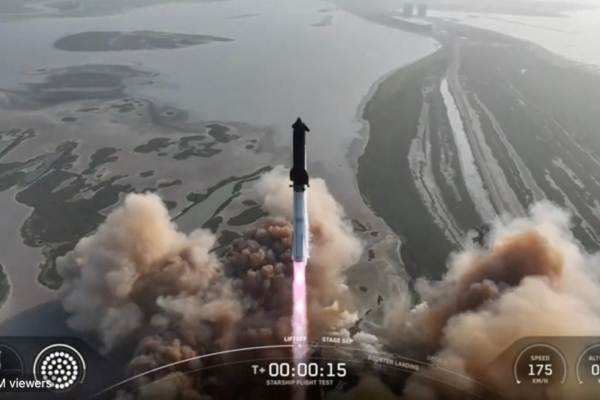On Tuesday, May 27th, the futuristic SpaceX Starship blasted off from the Starship Base in Texas for its ninth unmanned test launch. The flight covered a greater distance than the previous two test flights, but the spacecraft lost control upon re-entry into the atmosphere. The test results revealed that while the Starship achieved some significant milestones, it fell short of meeting some critical testing objectives.
The two-stage spacecraft, consisting of the Starship spacecraft mounted on the towering SpaceX Super Heavy rocket booster, launched from the Starship Base near Brownsville, Texas, at 7:36 p.m. Eastern Time.
During the live broadcast of the launch by SpaceX, the powerful Raptor engines of the Super Heavy rocket roared to life as the rocket ship ascended from the launch tower, soaring into the sky with a burst of flames and a billowing cloud of exhaust and steam.
As expected, the liftoff was very successful. The 232-foot (71-meter) long first-stage rocket separated from the Starship upper-stage rocket a few minutes after launch and returned to Earth.
The Super Heavy rocket booster, which had previously completed a mission, successfully ignited all 33 engines. This marked SpaceX’s first reuse of the Super Heavy booster, aiming to validate its reusability.
However, SpaceX’s ground control lost communication with the booster during its descent, speculating that the Super Heavy booster might have plunged into the ocean rather than conducting a controlled splashdown as planned.
The Starship upper-stage rocket continued its ascent and reached its planned suborbital trajectory after about 9 minutes of flight.
A mishap occurred during the test flight as the payload bay door of the Starship failed to open, preventing the deployment of eight simulated satellites as intended, thereby hindering SpaceX’s ability to test how the Starship would deliver cargo into orbit.
As per the plan, the Starship was supposed to complete a controlled descent and splashdown in the Indian Ocean within less than 90 minutes.
However, about half an hour after the launch, SpaceX announced that the flight team had lost control of the Starship’s attitude, causing the spacecraft to spin as it continued its descent back into the atmosphere.
During the live broadcast, SpaceX’s communications manager, Dan Huot, stated, “We’ve been dealing with some leaks on the vehicle. That was what led to the loss of control.” He added, “So we are in a bit of a dangerous situation right now.”
“We are unable to conduct the entry burn as expected,” a SpaceX commentator later mentioned during the broadcast, “the likelihood of [the Starship] landing successfully is very slim.”
Any object entering the Earth’s atmosphere at roughly 20 times the speed of sound will undergo intense physical processes. “We expect temperatures on the vehicle to reach about 1400 degrees Celsius,” said SpaceX’s Jessie Anderson.
The pressure and friction will result in the accumulation of intense heat, potentially leading to the disintegration of the Starship, with debris falling into the ocean.
The outcome of the ninth test flight of the Starship can be seen as a mixed bag of both joy and sorrow.
The spacecraft achieved more milestones during this flight than ever before, covering a much greater distance than the previous two test flights, which had failed within minutes of liftoff.
However, there were also issues in orbit as several critical technology demonstrations failed to materialize, and the spacecraft did not successfully conduct a controlled splashdown in the Indian Ocean.
With SpaceX conducting an investigation into the cause of the malfunction, more information is expected to be available to the public in the coming days and weeks.
Just four days ago, federal regulatory authorities approved SpaceX’s latest flight attempt with the Starship, concluding an accident investigation that had grounded the Starship for nearly two months.
The previous two test flights of the Starship in January and March ended in explosions shortly after liftoff, raining debris over parts of the Caribbean, disrupting dozens of commercial flights in the region.
The Federal Aviation Administration expanded the debris hazard area around the ascent path of Tuesday’s launch.

